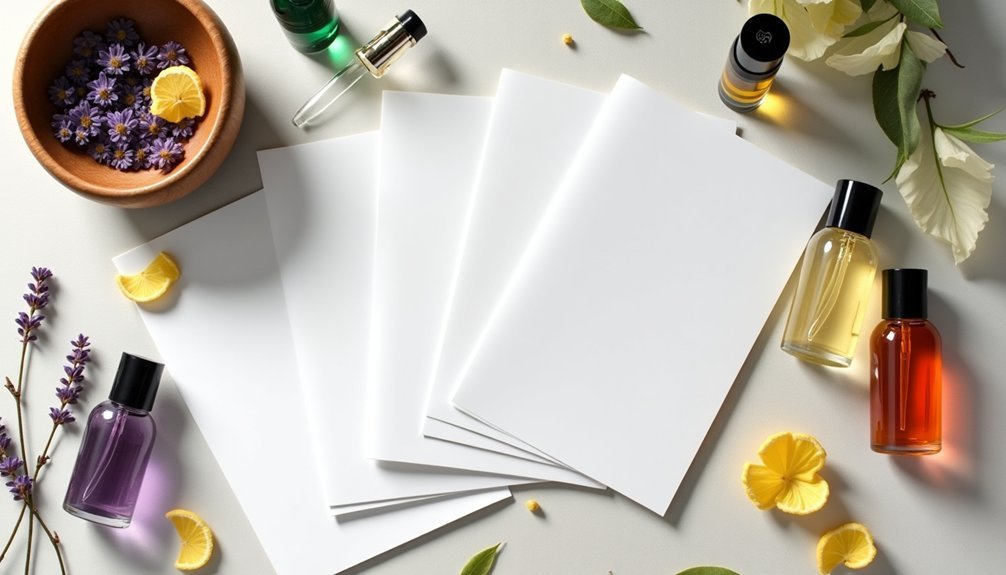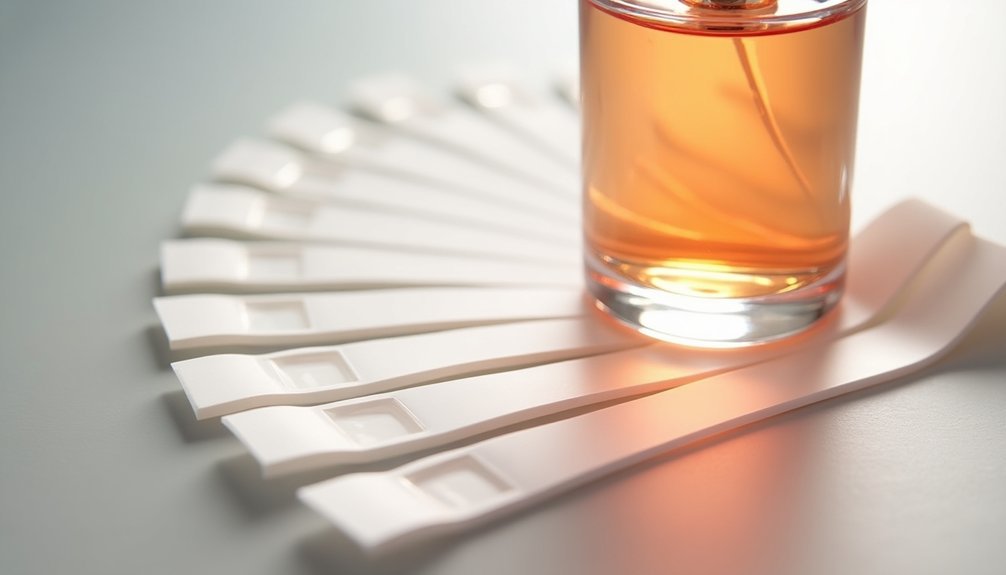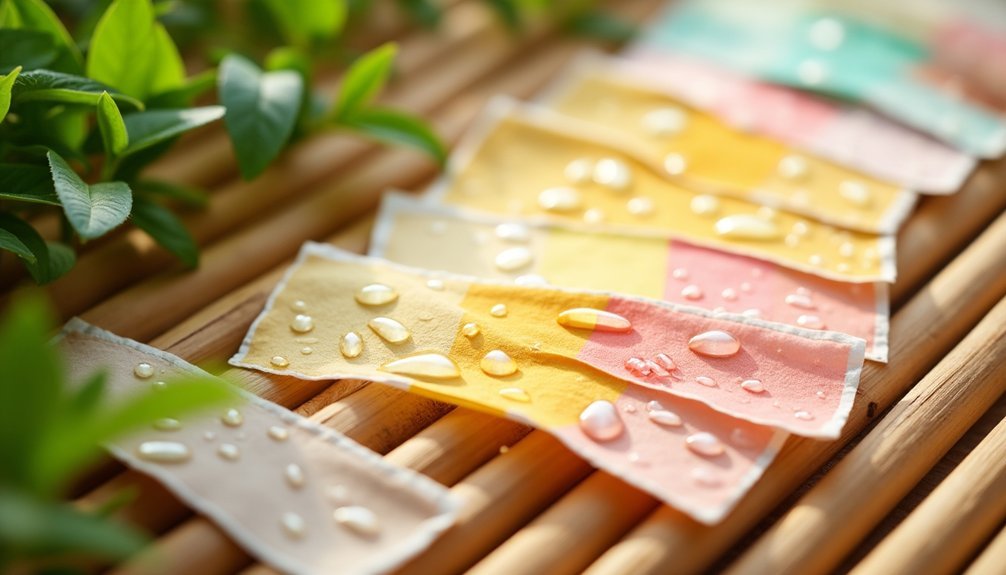You'll find excellent perfume test strips using common household materials like filter paper, heavy cardstock, or even coffee filters cut into 5-inch paddle shapes. For best results, choose highly absorbent papers free from contaminants and cut them to a tapered design – wider at the top (1/2 inch) and narrower at the bottom (1/4 inch). Store your strips in airtight containers and handle them by the edges. Our detailed guide explores seven practical solutions to elevate your fragrance testing experience.
Essential Materials for DIY Perfume Test Strips

Making your own perfume test strips starts with selecting the right materials. For ideal results, you'll want to choose highly absorbent materials like filter paper or heavy cardstock that can effectively capture essential oils and fragrances during testing.
Choose filter paper or heavy cardstock when making perfume test strips – their absorbent qualities are perfect for evaluating fragrances effectively.
When creating your Essential Oils Test Tester strips, cut them into paddle shapes approximately 5 inches in length. This design gives you plenty of space to write notes and evaluate different scent profiles.
You'll want to ascertain you're using clean, uncontaminated paper, preferably from eco-friendly sources, to maintain scent purity. If you need to label your Perfume Test Strips, opt for soy-based or non-toxic inks that won't interfere with the fragrance.
Remember to store your finished strips in a cool, dry environment to preserve their scent-holding capabilities.
Proper Strip Size and Shape Selection
When selecting perfume test strips, you'll find that thin paddle-style strips measuring 5 inches long with a 1/2-inch top width provide ideal handling and sufficient space for notes.
The tapered shape, narrowing to 1/4 inch at the bottom, enhances your ability to concentrate the fragrance while maintaining proper absorption rates.
Your testing experience will be more effective with these dimensions, as they prevent scent overload while allowing you to sample multiple fragrances efficiently.
Ideal Strip Dimensions
The dimensions of perfume test strips play an essential role in achieving accurate fragrance evaluations. When selecting Test Strips Perfume Essential tools, you'll want to follow ideal strip dimensions that experts recommend: 5 inches in length with a tapered width from 1/2 inch at the top to 1/4 inch at the bottom.
| Feature | Specification |
|---|---|
| Length | 5 inches (127mm) |
| Top Width | 1/2 inch (12.71mm) |
| Bottom Width | 1/4 inch (6.38mm) |
These measurements aren't arbitrary – they're designed for peak performance. The narrow profile prevents scent overload while the tapered shape improves handling. You'll find that thinner strips absorb fragrances better, requiring less perfume for testing. If you're planning to take notes during evaluations, consider paddle-style strips that offer extra writing space.
Shape Impact on Testing
Selecting proper strip dimensions and shapes can make or break your fragrance testing experience. When choosing perfume testing strips, you'll want to focus on designs that enhance your evaluation process.
The paddle-style strips give you plenty of space to jot down your observations, while the narrow dipping end guarantees precise fragrance application. For best results, look for tester strips around 5 inches long, which provide comfortable handling during your assessment.
You'll find that thinner strips often deliver a more natural scent experience, as they won't overwhelm your senses like thicker alternatives might. Consider how you'll use the strips – if you're planning extensive note-taking, opt for wider paddle designs, but if you're doing quick scent comparisons, slim strips might serve you better.
Size Versus Absorption Rate
Properly balancing strip size with absorption rate proves essential for accurate fragrance testing.
You'll want to select strips that measure around 5 inches in length, featuring a narrow design that's 1/2 inch at the top and tapers to 1/4 inch at the bottom. This size configuration maximizes your testing experience while preventing sensory overload.
When considering absorption properties, look for imported paper materials with strong hygroscopic qualities.
You'll find that thinner strips often perform better than thicker ones, as they don't require multiple sprays to achieve suitable fragrance retention. The paddle-style design offers a prime balance between size and absorption, giving you enough space to make notes while maintaining peak scent concentration.
Natural vs. Synthetic Paper Considerations
When choosing between natural and synthetic paper test strips, you'll need to weigh several important factors that can affect your fragrance testing experience.
Natural strips, like ELEVEN EVER's sustainably sourced options with soy ink, offer an eco-friendly solution that effectively holds both water and oil-based scents. However, they might release a subtle paper scent that could interfere with your perfume testing.
Synthetic strips provide superior durability and moisture resistance, which helps prevent quick fragrance absorption and enables longer-lasting scent evaluation. They're particularly useful when you need consistent results over extended testing periods.
Your final choice will likely depend on your priorities – if environmental impact matters most, opt for natural strips. If you're focused on precision and longevity in fragrance testing, synthetic options might serve you better.
Absorption Rate and Testing Effectiveness

You'll find that high-quality perfume test strips made from specialized papers offer superior absorption rates compared to basic paper alternatives, particularly when testing oil-based fragrances.
The ideal material composition allows the strip to capture both water and oil-based scents while maintaining the integrity of each fragrance note during evaluation.
When you're testing multiple scents, this enhanced retention capability guarantees that each fragrance maintains its distinct characteristics throughout your sampling session.
Strip Material Comparison
The science of perfume testing relies heavily on the material composition of test strips. You'll find that imported paper tester strips with soy ink, like those from ELEVEN EVER, deliver superior absorption for both water and oil-based fragrances.
When comparing materials, thickness matters considerably. Thinner strips provide better control during scent evaluation, as they won't overwhelm your senses. In contrast, thicker strips require more fragrance to achieve the same effect. The paddle-style strips, common in professional testing, offer additional space for your notes while maintaining ideal absorption rates.
Consider the strip's stiffness and hygroscopicity when making your selection. Pre-dried strips minimize contaminants and guarantee more accurate testing results.
You'll want to choose materials that balance durability with proper absorption to get the most reliable fragrance evaluation experience.
Oil Retention Performance
Superior oil retention proves essential for accurate fragrance testing, and today's high-quality test strips deliver exceptional absorption rates.
You'll find that modern testing strips, particularly those from ELEVEN EVER, quickly absorb both water-based and oil-based fragrances, allowing you to evaluate scents within seconds of application.
The high absorption capacity guarantees that oils remain properly distributed across the strip's surface, giving you a true representation of the fragrance's character.
With these strips' efficient retention properties, you can trust that your scent evaluations will be reliable and consistent.
The paddle-style design adds practicality, providing space to jot down your observations as you compare different fragrances.
Users consistently report excellent performance, with the strips maintaining their structural integrity while effectively holding oils throughout the testing process.
Storage and Handling Best Practices
Proper storage and handling of perfume test strips plays an essential role in maintaining their effectiveness.
You'll want to store your strips in a cool, dry area, away from direct sunlight to preserve their scent-absorbing qualities. Keep them in their original packaging or transfer them to an airtight container to shield them from moisture and unwanted odors.
When handling the strips, always grasp them by their edges to prevent oil transfer from your fingertips, which can compromise your fragrance evaluation.
Before storing used strips, make sure they're completely dry after fragrance application.
Don't forget to label each strip with the perfume name and testing date – this simple step helps you track your scent evaluations and makes future comparisons much easier.
Environmental Impact of Strip Materials

Beyond proper storage practices, understanding the environmental footprint of perfume test strips can help you make sustainable choices. When you select strips made with imported paper and soy-based inks, you're making an essential contribution to reducing petroleum consumption and carbon emissions.
The environmental benefits of these strips extend beyond their materials. You'll find that their high absorption capacity for both water and oil-based fragrances means you'll waste less product during testing.
The disposable nature of these strips, while seemingly counterintuitive to sustainability, actually promotes better hygiene and prevents cross-contamination, which could otherwise lead to wasted perfume samples.
Professional vs. Homemade Strip Comparison
When choosing between professional and homemade perfume test strips, you'll notice significant differences in their performance and usability. Professional strips, like ELEVEN EVER, offer superior absorption and contamination-free testing, while homemade alternatives might compromise your perfume evaluation accuracy.
| Feature | Professional | Homemade |
|---|---|---|
| Absorption | High capacity | Variable |
| Note-taking | Paddle design | Limited space |
| Quantity | Bulk packaging | Custom amounts |
| Consistency | Standardized | Unpredictable |
While you can create test strips from cardstock or paper at home, they won't match the specialized properties of professional options. If you're serious about perfume testing, professional strips provide reliable scent evaluation and convenient features like dedicated writing space. However, if you're only testing occasionally, homemade strips might suffice for basic fragrance sampling.
Frequently Asked Questions
What Can I Test My Perfume on at Home?
You can test perfumes on specialized scent strips, which you'll dip in fragrance or apply drops directly. Hold them a few inches from your nose for the best evaluation of your favorite scents.
What Is the Best Solvent for Perfume Making?
You'll find that ethanol (pure alcohol) is your best solvent for perfume making. It dissolves fragrance oils effectively, evaporates cleanly, and helps your scents diffuse beautifully. Avoid rubbing alcohol, as it's too impure.
How Can I Test Multiple Perfumes at Home?
You'll need high-absorption test strips to sample multiple fragrances. Dip each strip, label it, and keep them 3-5 inches from your nose. Let scents dry between tests and avoid wearing other perfumes while testing.
How Do You Test Perfume Lasting?
Apply perfume to your pulse points and don't rub it in. Let it dry naturally, then track how the scent develops over several hours. Notice when it fades and how the fragrance changes on your skin.
In Summary
You'll find that making your own perfume test strips gives you both control and sustainability in your fragrance testing journey. Whether you choose coffee filters, watercolor paper, or other materials discussed, remember to store them properly and handle them with clean hands. While professional strips have their place, your DIY solutions can be just as effective and more environmentally conscious when done right.





Leave a Reply